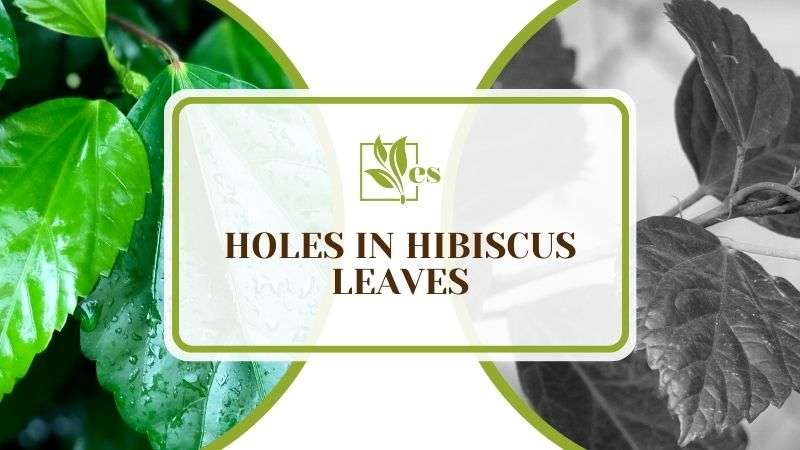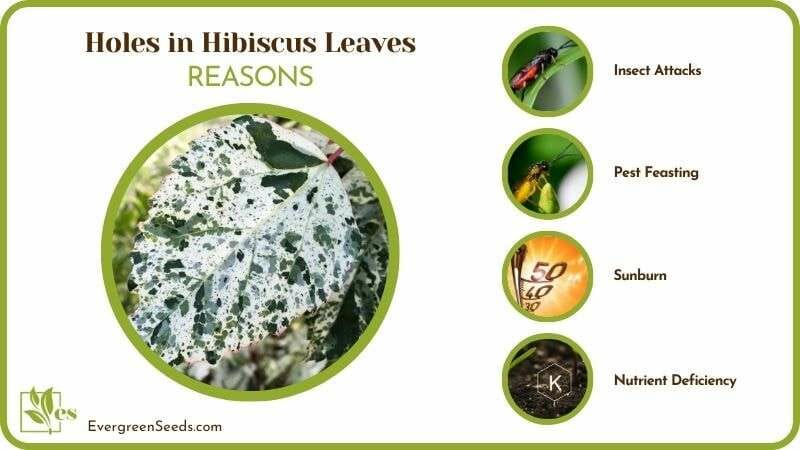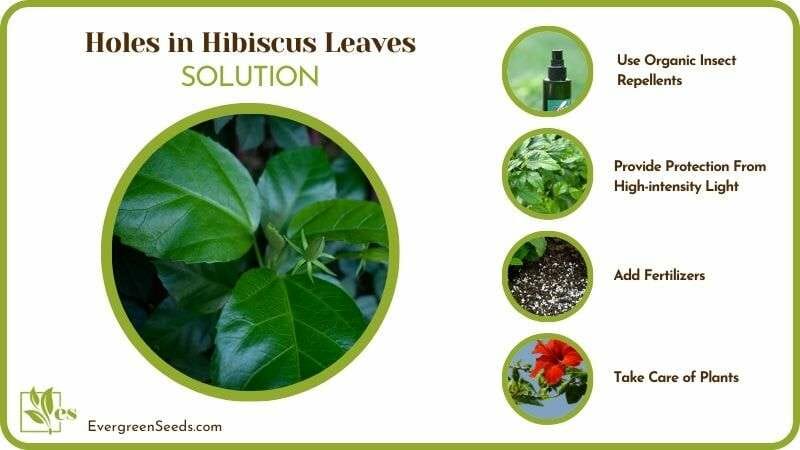When you observe holes in hibiscus leaves, the plant faces problems like insect infestation, mineral deficiency, sunburn, and physical damage.

If you wait to do something quickly, you will see many ruptures in every plant leaf.
So stick to the end to know all the causes and how to fix this problem.
JUMP TO TOPIC
What Are the Causes Behind Holes in Hibiscus Leaves?
The main reasons behind holes in hibiscus leaves are insect and pest attacks. These unwanted creatures puncture the leaves, drinking the fluid inside. Furthermore, nutrient or mineral deficiencies, physical damage, disease attacks, and sunburn can deform the leaves with holes.
– Insect Attacks
One common reason that causes holes in the leaves of hibiscus plants is insect infestation. They feast on the leaves, which eventually creates irregular holes. Let’s have a look at which insects attack hibiscus.
Hibiscus sawfly is this plant’s enemy. It is a wasp-like insect that punctures the leaves just to lay eggs. These larvae are typically green in color.
Aphids can also make very tiny holes in the leaves. They suck the sap to fulfill its hunger. But leaves are not the only place aphids attack. People often ask- “What is eating my hibiscus buds?” The main culprit is aphids, who also feast on young buds.
Whitefly is another insect that you will see near the hibiscus. It loves the underside of a leaf, so you will spot more of them there. It punctures the leaf to suck the sap, causing holes to appear. This insect also lays around 400 eggs at once, and the larvae from these eggs also eat leaves.
“Why do my hibiscus leaves look like lace?” When you see Japanese beetles on the plants, prepare to ask yourself this question. It is a colorful insect with green, blue, and brown shades. But if you see more of them, the beetle infestation can even devour whole leaves, leaving behind only veins.

When you see holes in hibiscus buds, chances are thrips have attacked the plant. This insect loves to suck the juice within the leaves, buds, and flowers by puncturing them. Due to this attack, you will see holes everywhere.
In addition to thrips, spider mites also puncture holes in the hibiscus. Check for webbing on hibiscus flowers, leaves, and stems to identify its infestation. So, how to protect hibiscus from insects? You will find out later in this article.
– Pest Feasting
Are you asking yourself – what is eating my hibiscus at night? Then the answer is pests (in most cases). Pests include birds, rabbits, squirrels, etc. If these creatures often come into your house, they will nibble or eat the juicy leaves at some point. Unfortunately, this will also cause big holes in the leaves, usually in the upper region.
– Sunburn
Hibiscus loves sunlight. It can thrive even if the light falls on them for over eight hours. But leaf scorching or sunburn can happen if you live in hot areas where the light gets intense on a summer day.
In this condition, the leaf cells die, causing tiny spots to emerge. If the light intensity stays high, these spots can turn into holes with time. The problem can worsen with dry wind or low humidity levels.
– Physical Trauma
Leaves can also have holes if the plant has faced physical damage. Generally, the damage occurs during transplantation. However, leaves may have gotten damaged during the process if you have recently relocated pots.
In addition, storms and strong dry winds can also cause physical trauma. In these situations, the winds “cut” a leaf section, which will look like an irregular hole. Furthermore, heavy rainfall can also harm leaves by damaging the leaf surface, but in rare cases.
– Nutrient Deficiency
Lack of nutrients can also cause holes to appear in the leaves. The nutrients are critical for internal processes, which maintain leaf structure. Generally, an insufficiency of potassium and manganese deforms the leaf surface.
When there is potassium deficiency, you will observe pin-like holes on the older and upper leaves. In the case of manganese deficiency, elongated holes will be on the weaker or wilting leaves.
– Disease Damage
When you see yellow leaves with holes, the hibiscus might face a disease attack. The top two that puncture the leaves are leaf spots and powdery mildew. In both diseases, leaf tissues get damaged, which eventually causes piercing.
Furthermore, the diseases also impact the root. When this happens, the mineral uptake won’t take place smoothly, which will cause nutrient deficiency. As discussed above, a deficiency of nutrients can also create holes in the leaves.
What To Do When the Leaves of an Hibiscus Plant Has Holes?
You should do the following when leaves of an hibiscus plant has holes: For this, try organic and chemical insecticides. You should also regularly apply fertilizers and follow plant care practices to ensure leaves stay in their original shape without deformity.
– Use Organic Insect Repellents
As insects are the main cause of holes, it is important to control their population. For this, you should go for organic repellents as they are affordable and environmentally friendly. We suggest first trying neem oil spray as it is the best homemade insecticide for hibiscus. Mix four tablespoons of this oil into a gallon of water (you can use hard tap water), fill it in a spray bottle and sprinkle it on the leaves.
You can also use diatomaceous earth, baking soda, wood ash, insecticidal soap, and sulfur powder. Some gardeners also prefer to get help from beneficial insects like ladybird beetles, green lacewings, etc., that eat bad insects and keep their population in check.
– Try Chemical Insecticides in Case of Severe Infestation
If the insect infestation is severe and organic repellents do not eliminate all these unwanted creatures, you should use chemical insecticides. Ensure to follow all the instructions and precautions printed on the bottle and box to avoid any problems.

Wear gloves, a mask, and a hat when applying chemical insecticides to protect yourself. Furthermore, only go to that area where you apply insecticides for at least six hours. It is because the fumes in the air can cause breathing problems.
– Provide Protection From High-intensity Light
When hibiscus gets more light than required, relocate these pots to a spot where they will stay protected from sunburn.
If changing the spot is impossible, provide shade during peak hours (when the light intensity is higher).
– Add Fertilizers
In addition to holes, plants face nutrient deficiency if you see leaves turning yellow and brown and you haven’t added fertilizers lately. We suggest you add organic fertilizers as they are cheap and do not make soil toxic. Also, know in advanced what type of soil you will use.
If the whole plant turns yellow and brown, the deficiency is severe. In this situation, add chemical fertilizers that are produced commercially. The reason is that chemical fertilizers release nutrients more quickly than organic ones.
– Take Care of Plants
Following plant care measures to protect hibiscus-damaged leaves is crucial. It would be best to uproot every weed in your garden as insects also reside and lay eggs on them. In addition, you should regularly monitor soil conditions. If you see any insects or eggs there, use organic repellents immediately.
Experts suggest removing any infected leaf or shoot to control the disease’s spread. You should also clean your garden daily to ensure it stays free from any dirt (a home of pathogens). Doing these things will keep all your plants, including your hibiscus, healthy.












